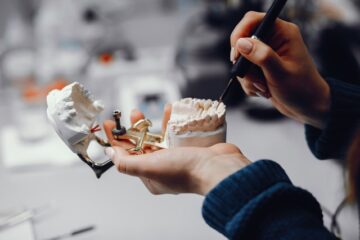How Teeth Are Prepped for Veneers | Step-by-Step Guide |

Contents
- 1 What Are Veneers and Why People Get Them?
- 2 Do Teeth Need to Be Shaved for Veneers?
- 3 Step-by-Step Process of Prepping Teeth for Veneers
- 4 Different Preparation Techniques (Minimal, No-Prep, Traditional)
- 5 Do Prepped Teeth Last Forever?
- 6 Risks, Myths & Safety: What You Should Really Worry About
- 7 Expert Advice From Dentists: When Prepping Makes Sense
- 8 FAQ About Teeth Prepped for Veneers

If your teeth lose their pristine color due to environmental factors or inherited diseases, it’s not the endmost sentence. A set of veneers can restore your smile even if you lost the genes lottery. Nowadays you can obtain veneers in almost every dental office worldwide. Many people fear that prepping teeth for veneers will harm their oral health, giving up their dream of achieving a luminous smile. Let’s discover what is stashed behind veneer teeth prep to keep you sufficiently informed about this aesthetic dental procedure.
What Are Veneers and Why People Get Them?
A dental veneer is an artificial tooth-colored shell, custom-made in collaboration with a dentist and lab technicians for aesthetic goals. All types of veneers allow you to cope with a bunch of dental issues such as:
- gaps in teeth;
- protruding teeth;
- yellowish tooth shade;
- uneven or overlapping teeth;
- chipped or broken teeth.
When you collaborate with a well-versed professional, your smile becomes gap-free, straight, and balanced. These tiny artificial shells can be personalized to your natural tooth shade, so nobody will ever guess your renewed smile springs from dentistry achievements. A set of veneers adds to a younger look and amplifies confidence by covering petty imperfections you’d rather not want others to notice.
Cosmetic and functional benefits
An artwork of cosmetic dentistry, veneers have certain prominent advantages:
- Transparent and natural look;
- Remarkable durability;
- Stain-resistance;
- Fix a bunch of cosmetic issues (tooth color, shape, chips, cracks, gaps between teeth, and minor misalignment);
- Minimally invasive procedure;
- Positively affect your self-confidence.
Each veneer type boasts unique pros and cons based on the material quality. For instance, the main difference between zirconium and porcelain veneers lies in their appearance and robustness. Porcelain looks more natural and translucent than solid zirconia, but the latter wins in terms of stoutness and durability.
Who is a good candidate?
Veneers can help you achieve the desired smile aesthetics, but you should be eligible for the procedure. If you are determined to obtain these cosmetic porcelain coverings, ensure you have good oral health and understand the procedure’s consequences. Before you get teeth prepped for veneers, ask your dentist to cure any neglected cavities or gum disease in your mouth. Your teeth and gums should be healthy to ensure a solid base for the veneer procedure.
Do Teeth Need to Be Shaved for Veneers?
To make room for a veneer, a doctor has to adjust the original shape of the tooth surface by shaving off a tiny amount of the enamel. This layer equals the veneer thickness to ensure a firm fit. A dental practitioner doesn’t need to entirely ground down teeth for veneers to bond them: they apply an adhesive to set the ceramic shell into place. Before the procedure, a dentist will comprehensively educate you on the question of “How are teeth prepared for veneers?” and to what extent.
How much enamel is removed?
The latest advancements in dentistry allow professionals to preserve a healthy tooth structure to the maximum. Tooth shaving causes many concerns, but a doctor doesn’t strive to harm your teeth. They process around 0,07–0,2 inches of enamel to make teeth prepared for veneers. This is essential for your aesthetic dental coverings to fit properly and securely.
Is the procedure painful or harmful?
Unlike a crown that envelopes the whole tooth, a veneer is wafer-thin. A tension-free smile makeover is usually performed under local anesthesia, completely sparing you from the pain in a dental chair. You might feel minor discomfort and sensitivity during and after the procedure but these sensations aren’t painful.
Step-by-Step Process of Prepping Teeth for Veneers
To prep teeth for veneers according to the established standards in dentistry, you should undergo the following steps.
- Initial consultation and treatment planning
This stage encompasses exchanging views on your dental aims, needs, and the type of preferred tooth coverings with a dentist. The doctor inspects your oral cavity and defines which veneer type is the most pertinent for you. Modern clinics are mostly supplied with innovative dental equipment, including CT Scan, CAD-CAM, 3D X-ray, digital impression appliances, and more. Therefore, you’ll have admittance to all advanced technologies and facilities needed for effective veneer placement.
It’s vital to share your medical information, including allergies, to enable the doctor to think over the course of treatment. Having all the essential data at hand, your dentist will offer the favorable number, color, size, and shape of cosmetic dental restorations for your approval.
- Tooth trimming and shaping
The doctor gently removes a tiny layer of enamel to let veneers firmly stick to the tooth surface. They process excessive teeth nubs before veneers to gently adjust the tooth shape and ensure your smile is as straight and aesthetically complementing your appearance as possible.
- Taking impressions and shade-matching
Afterward, a dentist takes your teeth imprint to make a mold for custom-fitted aesthetic dental coverings.
- Temporary veneers
Your processed teeth crave protection before permanent dental restorations are ready. To shield your teeth from potential harm, staining, and heightened sensitivity, the doctor may overlay temporary veneers. Such veneers aren’t a mere dentist’s whimsy: they help preserve tooth functionality.
- Final veneer placement
You’ll have to countdown around a week for the lab technicians to create custom tooth restorations. Digital scanning allows them to achieve the topmost accuracy while designing your future smile. When your unique set of veneers is available, the doctor uses an adhesive to fit them on top of your teeth, ensuring that your pearly whites are perfectly aligned.
Different Preparation Techniques (Minimal, No-Prep, Traditional)
Dentists use different methods to remove a tiny layer of enamel so that a veneer seamlessly fits in place. The choice of a preparation technique depends on several factors, including the veneer type and your individual case.
Pros and cons of each method
Let’s examine the advantages and drawbacks of the main veneer restoration techniques:
| Veneer Preparation Technique | Pros | Cons |
| Minimal tooth preparation | A thin layer of enamel (0,1–0,2 inches is removed);Preserves the original tooth structure;Less invasive procedure than traditional veneer placement;A precise fit;More natural-looking and long-lasting than no-prep veneers;Effective for pronounced cosmetic concerns. | The procedure is irreversible;Require more invasive processing than no-prep veneers. |
| No-prep veneers | Require little to no tooth preparation;Bonded directly to the front tooth surface; The most tooth-saving option among all;In certain cases, a dentist can remove these veneers without significantly damaging the teeth;Great for covering small gaps or stains. | Don’t suit patients with thicker teeth;Less effective for major cosmetic flaws;Concede to traditional veneers in terms of durability. |
| Traditional veneers | Create a natural-looking smile;Remarkable lifespan of 10–15 years;Effectively conceal major cosmetic flaws. | Require more significant tooth reduction than other veneer options;Once teeth are filed down, the procedure can’t be undone. |
How your dentist decides
A dentist evaluates the tooth position and defines the necessary fixes for the desired cosmetic outcome while preserving your teeth’ strength and functionality. They inform you on the extent your teeth require reshaping and suggest the most fitting option for your smile: minimal tooth preparation, traditional veneers, or no-prep veneers.
Do Prepped Teeth Last Forever?
Though veneers boast outstanding durability (around 15 or more years), they are not eternal. The lifespan is based on the material quality and your oral care. A conscious approach to oral hygiene and regular dental appointments are a must if you want your veneers to last for a long time.
What to expect in the long-term
Though permanent dental coverings are outstandingly long-lasting, the procedure is accompanied by ongoing maintenance and possible replacement expenditures. Once your original teeth are coated with porcelain or zirconium shells, the process can’t be undone. The underlying teeth become weaker and more sensitive, and you may need regular check-ups and in-office teeth cleanings to keep your dental investment in optimal condition. You can postpone the necessity for secondary restoration with proper care, diligent oral hygiene, and evading accidental damage.
Maintenance tips
Permanent dental shells are firmly fixed to the tooth enamel, so the aftercare doesn’t differ much from your original teeth. Follow these simple tips to prolong their lifespan:
- Meticulous Oral Hygiene. Brush your teeth with a soft-bristled toothbrush in the morning and before going to bed. Don’t forget to use dental floss daily.
- Sparing Diet. Avoid extra hard foods and tinted drinks. Remember your teeth are not tools and resist the temptation of using them this way.
- Regular Dental Check-Ups. Visit a dental office every six months for routine professional examinations to verify your aesthetic tooth coverings are all right.
Veneers are a pricey dental restoration, which requires conscious maintenance, dietary choices, and oral hygiene to last long.
Risks, Myths & Safety: What You Should Really Worry About
If you decide to get dental veneers, you should comprehensively study available offerings to find a dentist with vast experience and a verified reputation in cosmetic dentistry. With these means, you can avert the risks associated with unscrupulous veneer bonding:
- Tooth Nerves Exposure. It can happen if a doctor files too much enamel during preparation, increasing the risk of infection and the necessity for root canal treatment.
- Heightened Tooth Sensitivity. This painful state intervenes in trouble-free eating, drinking, or brushing your teeth.
- Poor-Fitting Veneers. If aesthetic dental restorations don’t utterly fit the size of your teeth or are insufficiently bonded, they can easily fall off.
- Gum Infection. It should be immediately treated, as neglected gums infection can reach the bone.
These cases are rare but it’s always reasonable to choose a reputed clinic that adheres to conventional standards of dentistry and follows strict sterilization protocols.
Does prepping teeth ruin them?
Even for traditional veneers, a dentist removes a tiny amount of tooth enamel. Your teeth will be safeguarded with temporary veneers till the permanent aesthetic coverings are ready. Tooth trimming for veneers is less invasive than for dental crowns or bridges, so it won’t ruin your teeth. However, you should understand that certain preparation techniques are irreversible, meaning once you get veneers, you are bound to perpetually care for them.
Can veneers cause sensitivity or decay?
Sometimes dental veneer placement can provoke tooth sensitivity that will eventually come off with time. These sophisticated tooth shells don’t cause tooth decay: the latter condition is a result of improper oral care or insufficient dental hygiene, like with your natural tooth.
Expert Advice From Dentists: When Prepping Makes Sense
The most reasonable decision is to adhere to this corrective method only when the existing cosmetic issues can’t be fixed by other dental means, such as restoration tooth fillings, Zoom whitening, and the like. The reason is that veneers aren’t reversible. Once performed, the process can’t be undone.
FAQ About Teeth Prepped for Veneers
Can veneers be applied without prepping the teeth?
In certain cases, like for no-prep veneers, their bonding doesn’t require teeth grinding. However, slight tooth reduction ensures a more secure fit of your veneers and increases their lifespan.
How long does the veneer preparation process take?
The exact time depends on various factors, including individual case complicacy and the type of material. On average, a dentist needs 1–2 hours to finish the preparation stage. You should wait for around a week till your permanent veneers will come out of the dental lab.
Does tooth preparation damage enamel permanently?
A dentist needs to file down a tiny layer of tooth enamel so that your veneers firmly adhere to your natural teeth. They won’t actually “damage” enamel as the procedure is as sparing to your teeth as possible if performed by a skilled professional. In some cases, like with traditional veneers or minimal tooth preparation, the process is irreversible, while no-prep veneers may not require tooth trimming at all. However, the latter option is not as durable as its preceding counterparts.
Can I reverse veneer treatment later?
On average, veneers can’t be reversed. This cosmetic dental treatment is designed to be permanent and requires conscious maintenance and diligent oral care.
Are there alternatives to traditional veneer prep?
Yes, a dentist can offer minimal tooth preparation or no-prep veneers if you are strongly against traditional veneer application. However, traditional veneers are best for major cosmetic issues and pose outstanding longevity.
Additional Resources
- Explore the study on the success of dental veneers based on preparation design and material type to contribute to a high aesthetic result of your restorative procedure.













